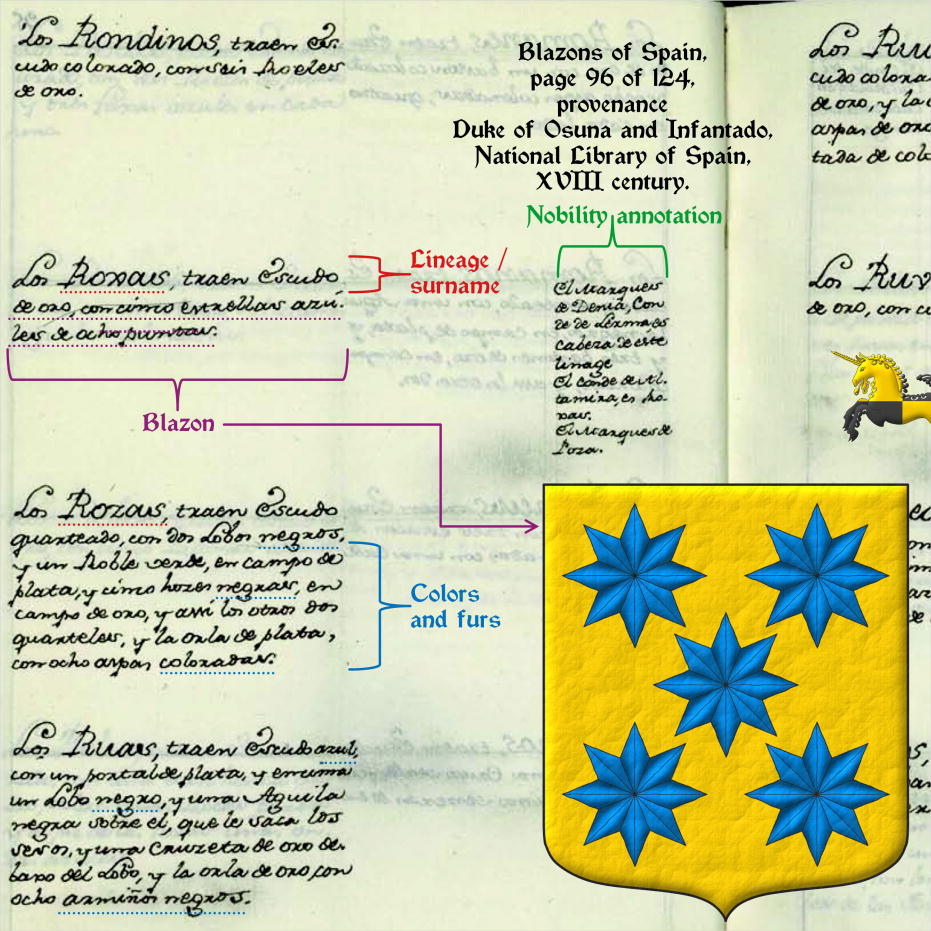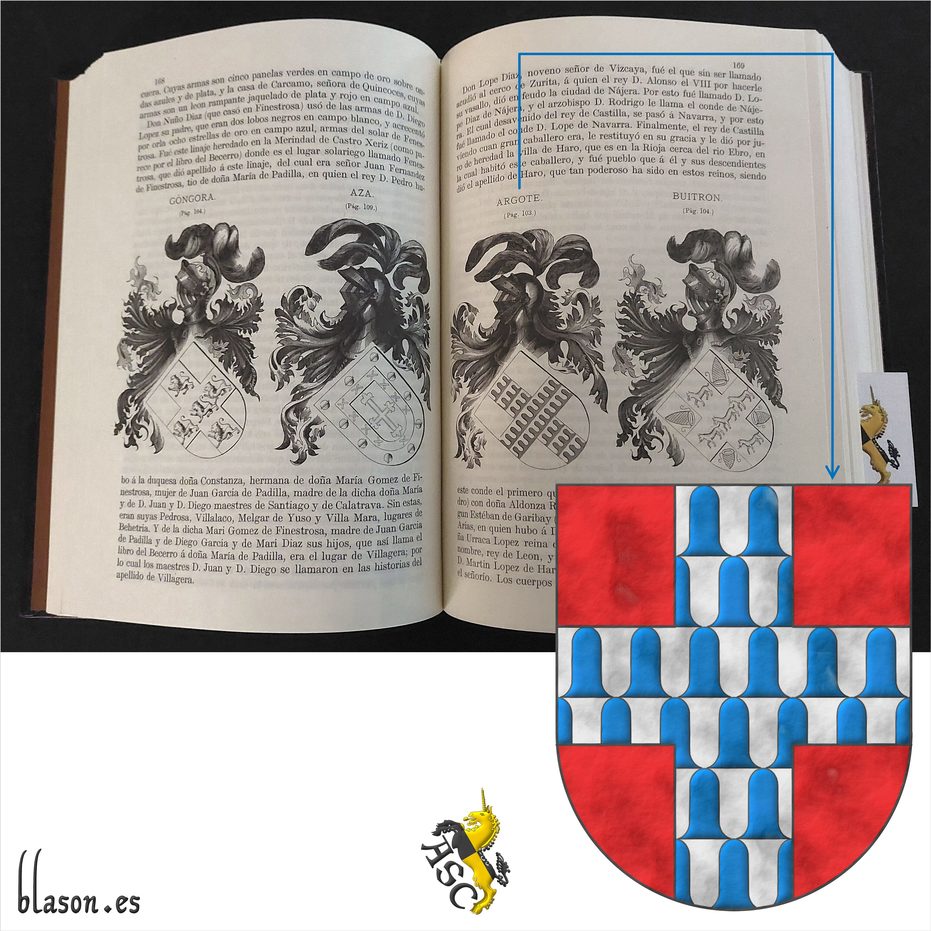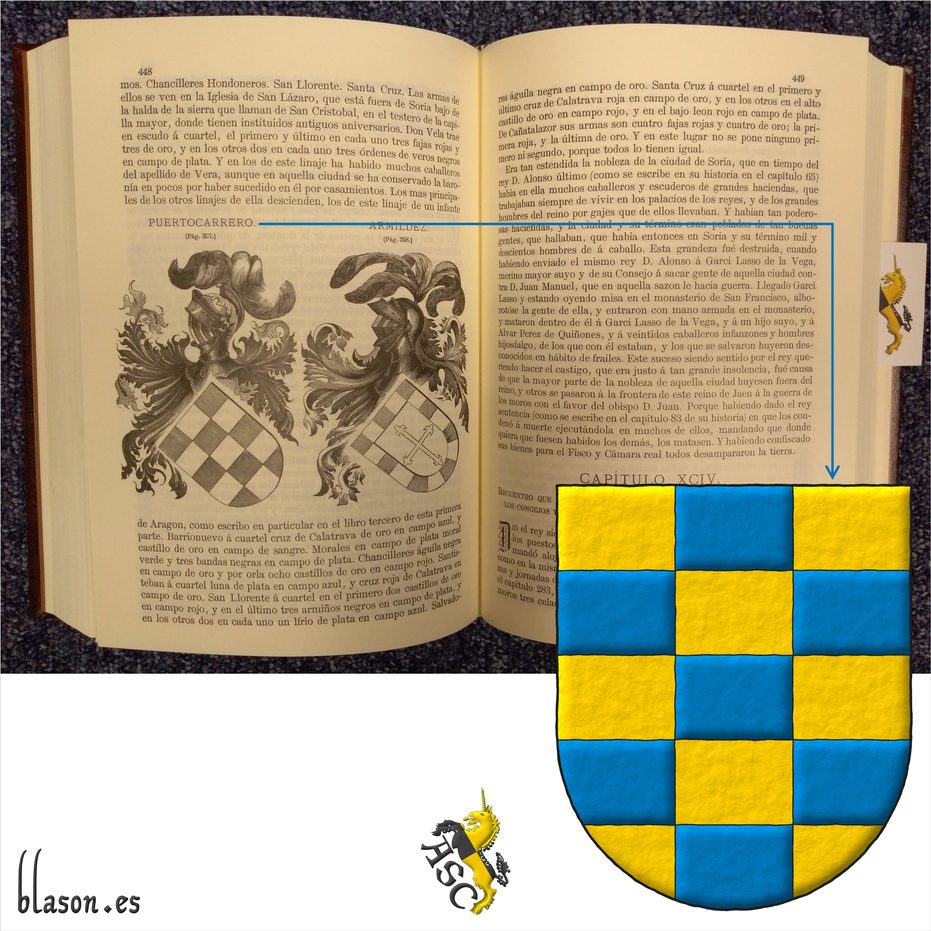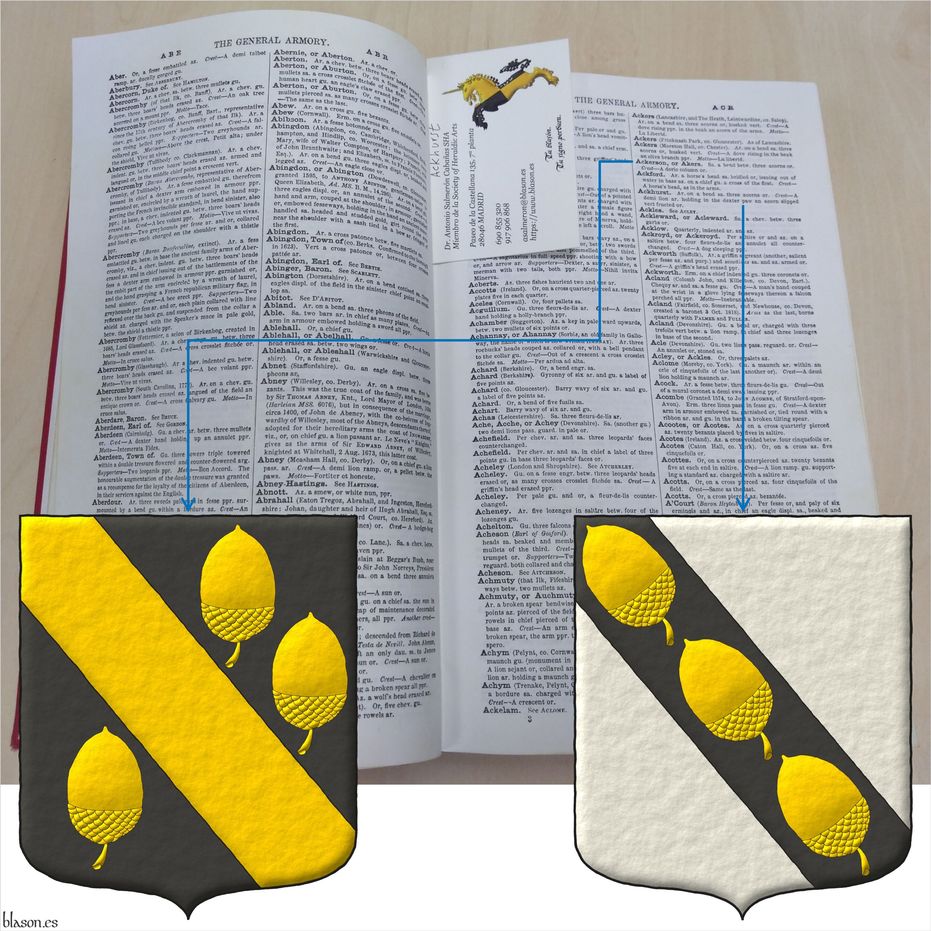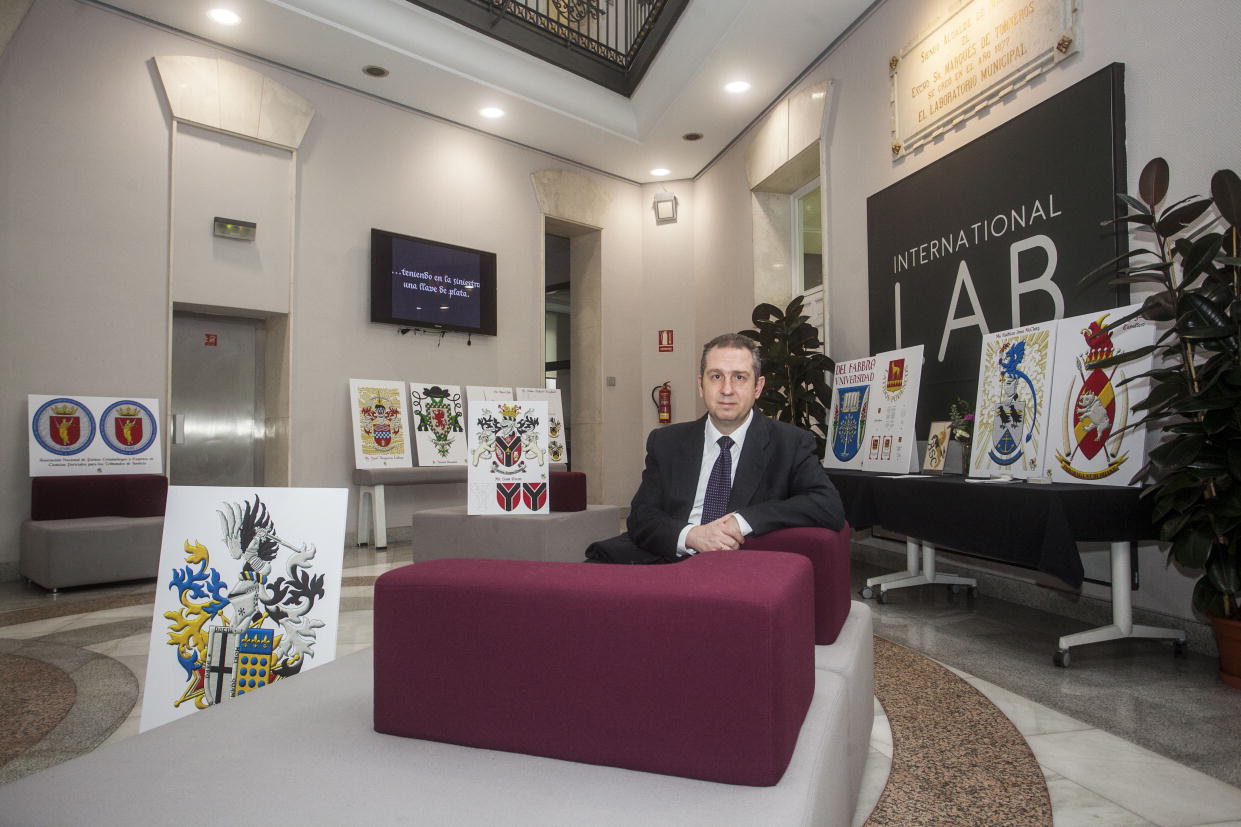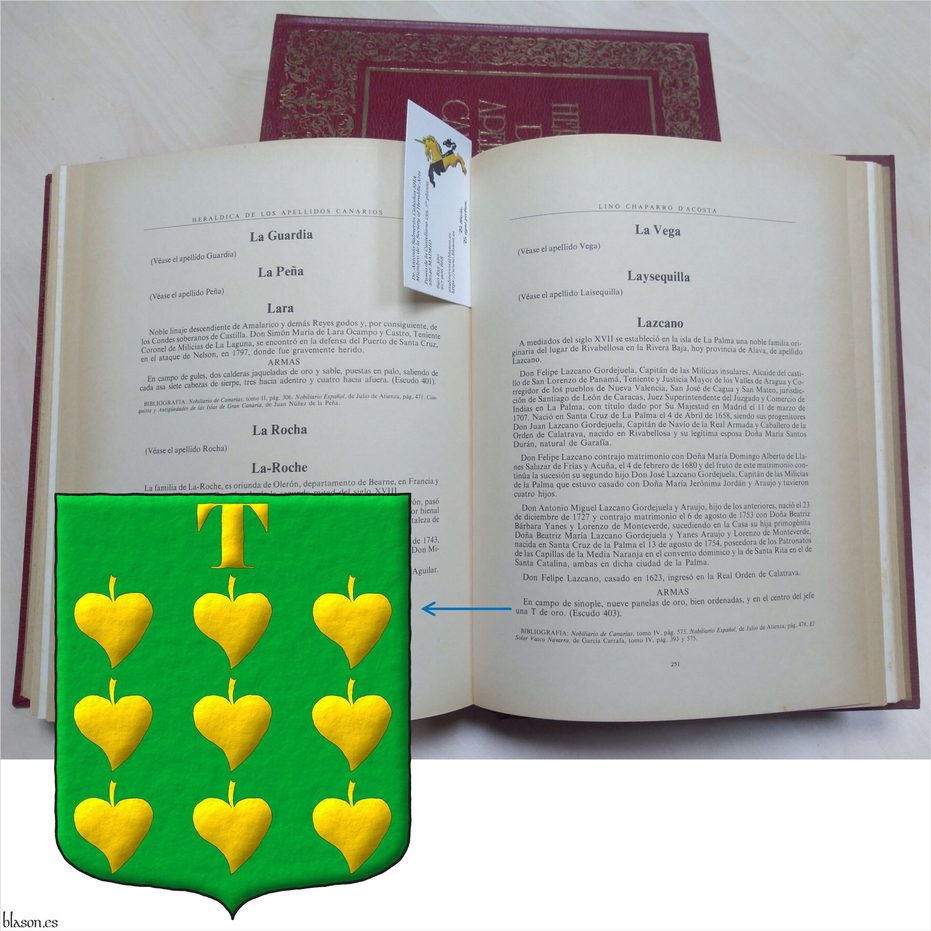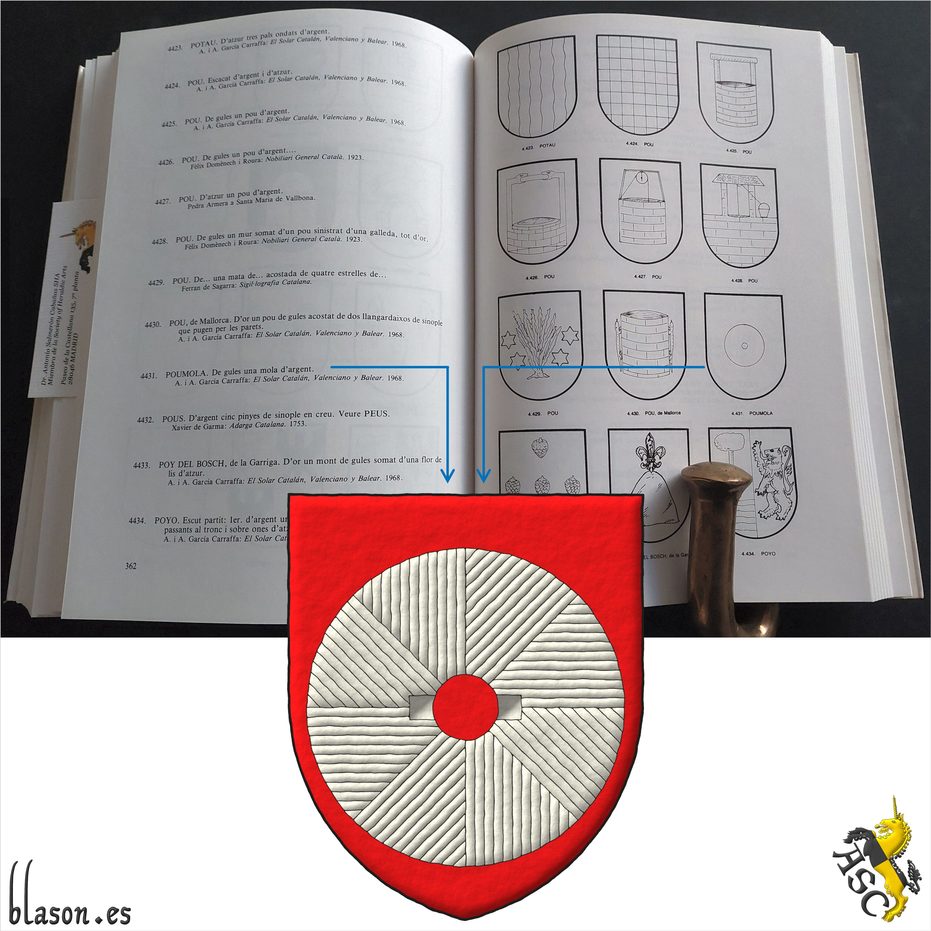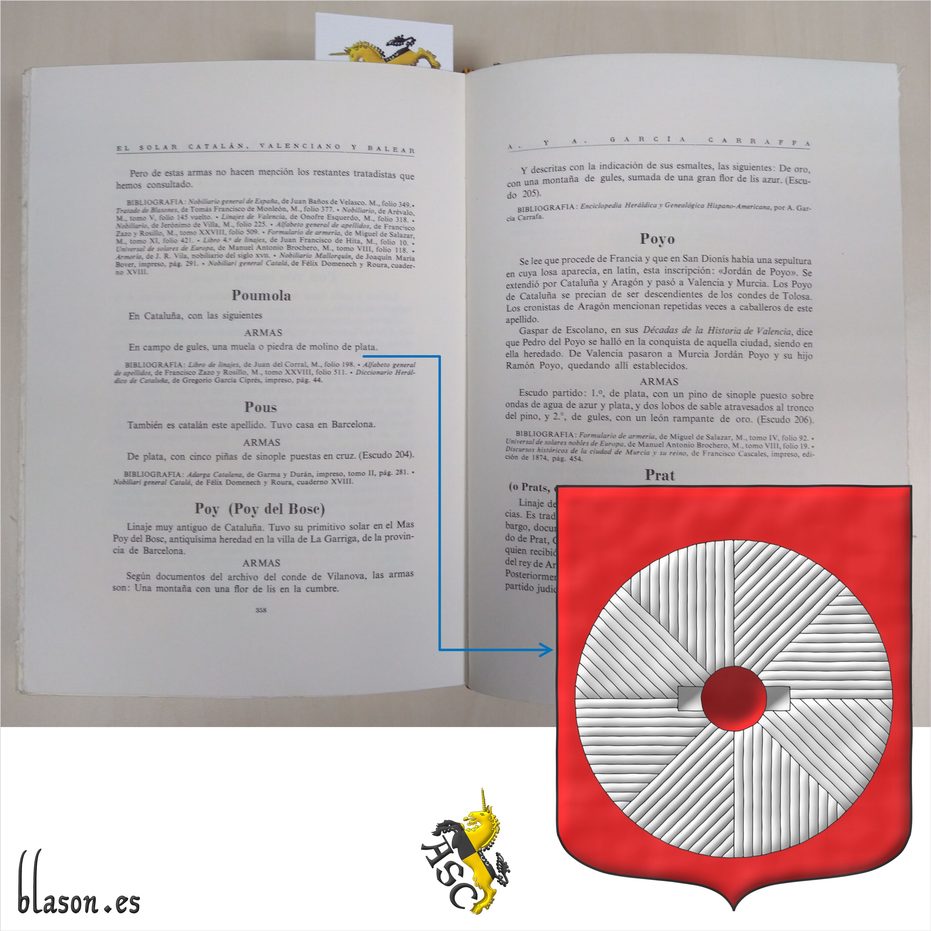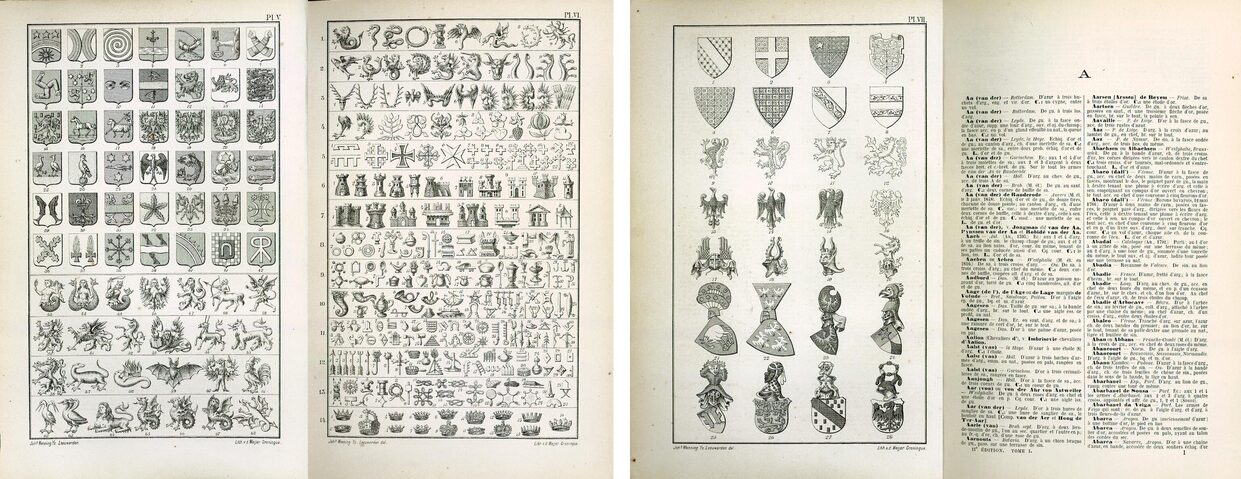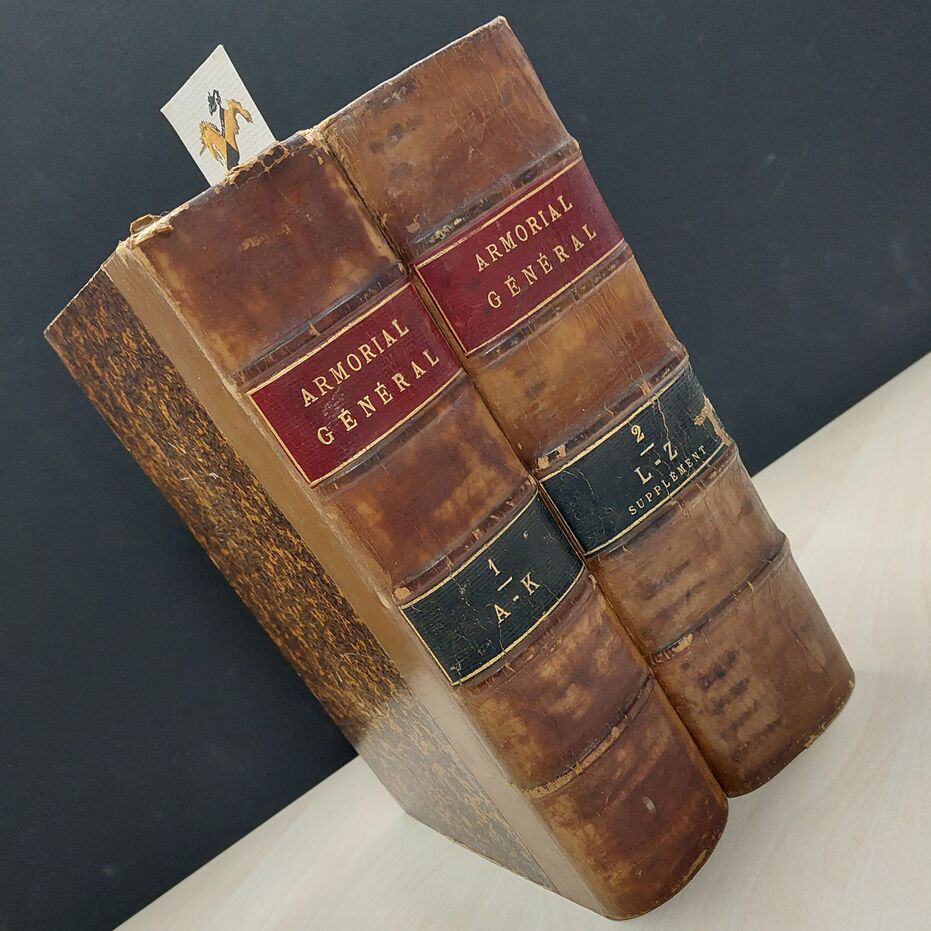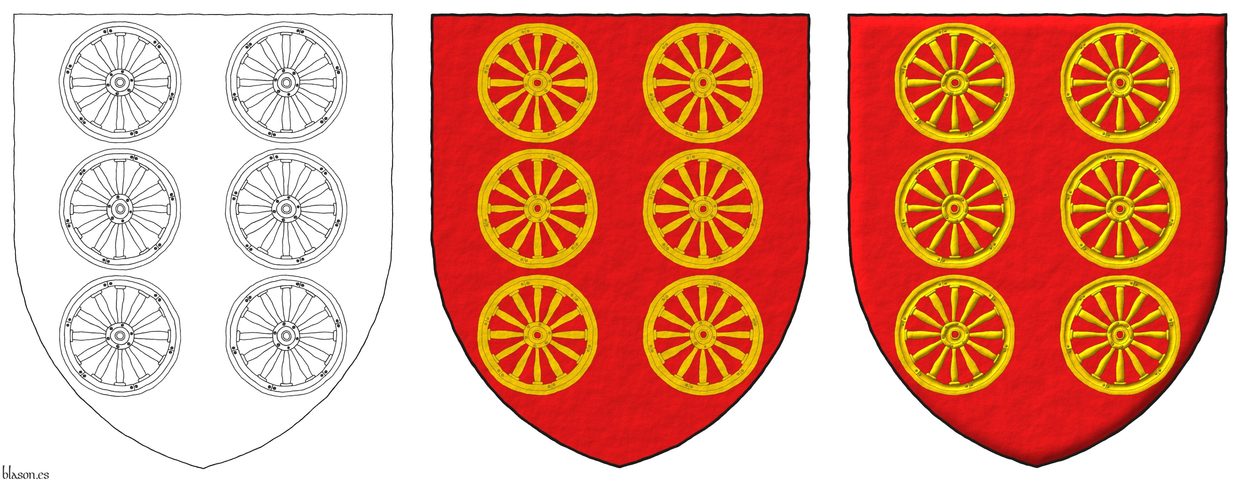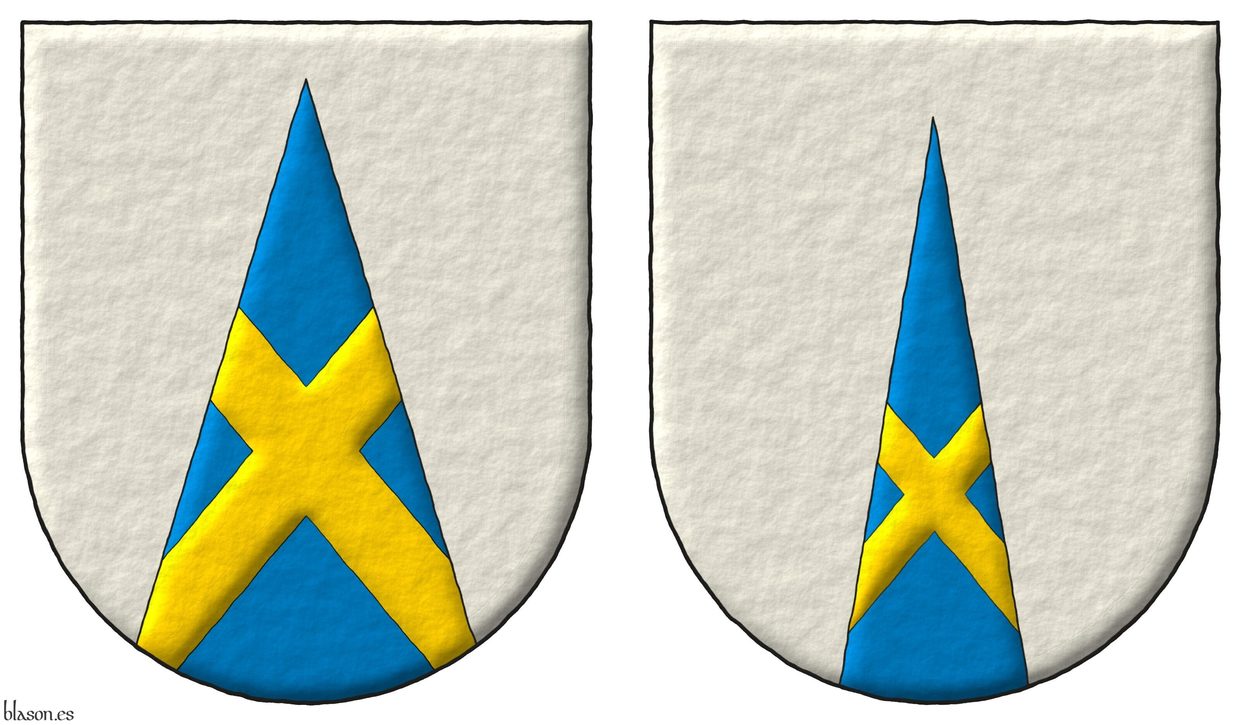Lineage


Aldam, lineage of England
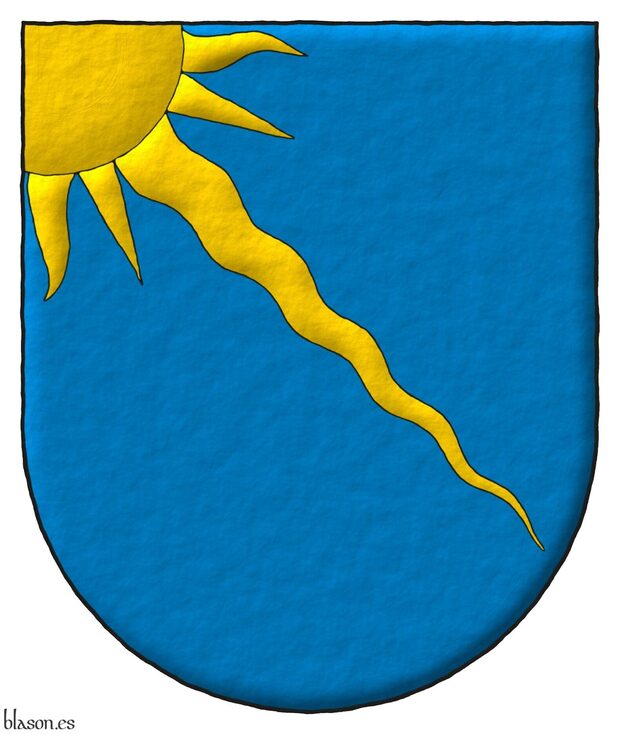
Blazon of the Aldam lineage of England.
Azure, a ray of the sun bendwise, issuant from the dexter chief Or.
Escudo de azur, un rayo de sol puesto en banda, naciente de la diestra del jefe de oro.
Illuminated with lights and shadows and with a freehand finish.
Described in [Burke, B.; 1989; page 9, column 1, entry 11].
Blazon keywords: Without divisions, Azure, One, Ray of the sun, Bendwise, Nascent, Dexter, Chief and Or.
Style keywords: Freehand, Outlined in sable, Illuminated and Semi-circular.
Classification: Interpreted, Lineage and Kingdom of England.


André, lineage of France
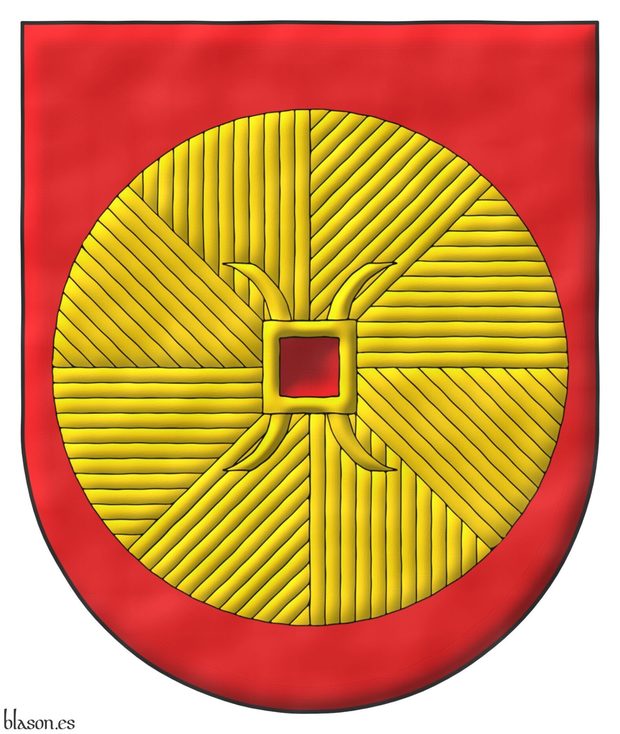
Blazon of the André lineage of France.
Gules, a millstone Or.
Escudo de gules, una piedra de molino de oro.
Illuminated and a watercolor finishing with shadow in the hole.
For its better identification, I have painted the millstone with the ring that fixes it to its axis. This ring is called a millrind, it is made of iron, and usually has 4 arms to better fix the millstone. Millrinds may appear on coats of arms independently of millstones. Another heraldic element related to the previous ones is the millwheel, which is a toothed gear that is part of the mill mechanism but should not be confused with the millstone that grinds the grain.
Blazon keywords: Without divisions, Gules, One, Millstone and Or.
Style keywords: Watercolor, Outlined in sable, Illuminated and Semi-circular.
Classification: Interpreted, Lineage and Kingdom of France.


![Ver [Anonymous; 1800a] en referencias bibliográficas. Libro abierto, hojas de plata, filo de oro, guardas de gules, tapas de sable.](../css/Libro.Bibliografia.png)
Anonymous; 1800a
Anonymous, «Armerías de España», 124 double pages, title in the page 9, provenance Duke of Osuna and Infantado, 1800.
Content
The book has no index and its content, written by hand, is as follows:
- Pages 1 through 8 are blank.
- On page 9, title, the letter A begins and surnames Abarca, Abendaño, Abeo, Ablitas and Abrego in large handwritten and the blazon in small handwritten (except for the end of the book on page 123, the unknown author seems to write more about surnames than about lineages).
- On page 10, the surnames with the letter A continue and their blazon both in small handwritten.
- On page 23, the letter B begins, its surnames and their blazons, for example, the Barrasas, in the page 25, «Or, six Lions proper, combatant».
- On page 30, the letter C begins, it is followed by the letter Z on page 42, 29 surnames with Z was written before the letter D and Cocas and Cuacas, with the letter C, are inserted inside the letter Z.
- It follows in alphabetical order of surnames from page 46, where the letter D begins, to page 97 with the letter S, including in the S the surname Sánchez on page 99, as a lineage will be included at the end of the book, and it follows with the letter S until the page 104.
- On page 105 the letter T begins, surname Tabixas, Taboadas, Tafuxes, ...
- On page 109 jump from the letter T to the letter V, with the surnames Vacas, Vadillos,... and skipping the letter U.
- On page 119, it returns from letter V to U, in an unordered manner and without including the title with the capital letter U.
- On page 120, begins the letter X and also the letter Y.
- On page 122, the letter Z and only 3 additional surnames with Z, recall that the majority of the surnames with Z were included after the letter C.
- On page 123 he returns to the surname Sánchez by testimony of Pedro de Soto owner of the books of Armory of Spain of Andreas Heredia, King of Arms, and finally the unknown author copies the text for the surname Sánchez, those who were «hijosdalgos, en Cangas de Gobadonga» ~ Covadonga of Asturias and ends with a poem of 8 verses. Andreas Heredia, also known as Andrés Heredia, was King of Arms during the reign of Philip III of Spain, [Nieto y Cortadellas, R.; 1957a; Page 4]
- Beginning on page 124 are blank.
Bibliographical reference of century XVIII.
Classification: Manuscript, Armorial roll, In black and white and Castilian language.
The author is unknown.
External links:
- Detail of this Armorial in the National Library of Spain.
- Bibliographic record of the National Library of Spain.
- Scanned Armorial in the National Library of Spain.
Internal resources: Osuna1800.ArmeriaEspaña.Manuscrito.pdf.


![Ver [Argote de Molina, G.; 1588] en referencias bibliográficas. Libro abierto, hojas de plata, filo de oro, guardas de gules, tapas de sable.](../css/Libro.Bibliografia.png)
Argote de Molina, G.; 1588
Gonzalo Argote de Molina, «Nobleza de Andalucía», dedicated to King Philip II of Spain, with about 500 coat of arms engraved, printed by Fernando Díaz, Seville, 1588.
There are other editions, for example, the edition by Francisco López Vizcaíno, 799 pages, Jaen, 1867, or facsimile edition by Riquelme y Vargas Ediciones SL, Jaén, 1991, my copy is the number 1268.
Bibliographical reference of century XVI.
Classification: Castilian language and In black and white.
Author: Argote de Molina, Gonzalo.
External resources:
- Virtual Library of Andalusia, 1867.
- Digital Library Madrid's memory, 1588 edition from page 6 missing cover and initial pages.
- National Library of Spain, bibliographic record, there are 2 copies of the edición of 1588.
- National Library of Spain, edition of 1588, cover of the first copy.
- National Library of Spain, edition of 1588, cover of the second copy, this has more resolution than the previous copy.
- Google Books, the second book and not complete.
Internal resources: ArgoteMolinaG1588.22.NoblezaAndalucia.Madrid.pdf is the edition of the year 1588 in PDF digital format, ArgoteMolinaG1588.23.Bne.Baja.resolucion.R10805.pdf is the edition of the year 1588 in PDF digital format and low resolution, ArgoteMolinaG1588.24.Bne.Alta.resolucion.R26842.pdf is the edition of the year 1588 in PDF digital format and hight resolution, ArgoteMolinaG1588.25.NoblezaAndalucia.1867.pdf is the edition of the year 1866 in PDF digital format for Adobe Reader only and a facsimile edition as a physical book on paper.


Bourgeois, lineage of Burgundy
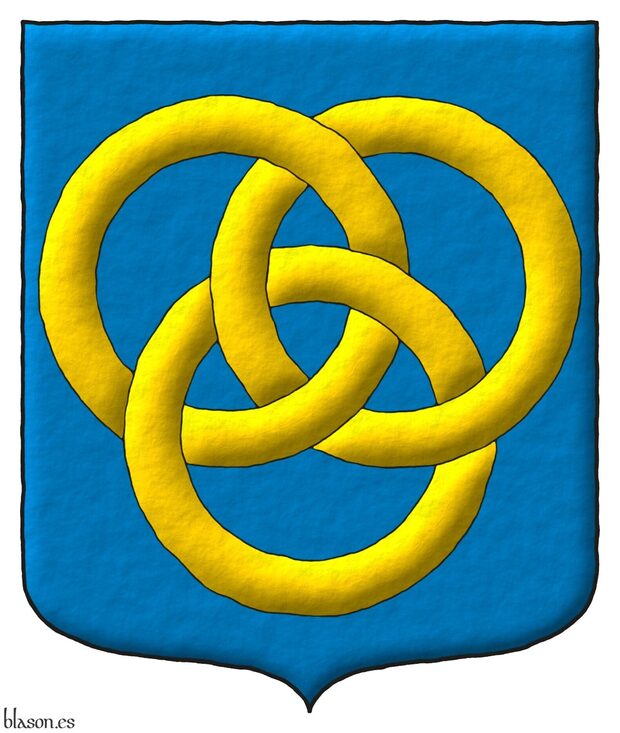
Azure, three annulets interlaced Or.
Illuminated, with a watercolor finishing and with a pointed shape.
You can found it at [Avilés, J.; 1725a; page 76 and illustration 177]], and at [Avilés, J.; 1780a; page 85 and illustration 177]].
Blazon keywords: Without divisions, Azure, Three, Annulet, Interlaced and Or.
Style keywords: Watercolor, Outlined in sable, Illuminated and Pointed.
Classification: Interpreted, Lineage, Kingdom of France and Coat of arms.


Bourgeois, lineage of Burgundy, France

Azure, three annulets interlaced Or.
Escudo de azur, tres anilletes entrelazados de oro.
Coat of arms emblazoned by me with plain color Azure and metal Or and with a shape ended with an ogee arch.
Blazon keywords: Without divisions, Azure, Three, Annulet, Interlaced and Or.
Style keywords: Watercolor, Outlined in sable, Illuminated and Ogee.
Classification: Interpreted, Lineage, Kingdom of France and Coat of arms.


![Ver [Burke, B.; 1842] en referencias bibliográficas. Libro abierto, hojas de plata, filo de oro, guardas de gules, tapas de sable.](../css/Libro.Bibliografia.png)
Burke, B.; 1842
Sir Bernard Burke, C. B., LL. D., Ulster King of Arms, «The General Armory of England, Scotland, Ireland and Wales; Comprising a Registry of Armorial Bearings from the Earliest to the Present Time», Harrison, London, 1842.
Sir Bernard Burke, C. B., LL. D. (1814-1892), also cited as John Bernard Burke, was a British genealogist. He was son of the genealogist John Burke (1787–1848). In 1853, Sir Bernard Burke was appointed Ulster King of Arms.
I use to consult [Burke, B.; 1989] and [Burke, B.; 2009].
Bibliographical reference of century XIX.
Classification: In black and white and English language.
Author: Burke, Bernard.
The following articles cite this bibliographic reference:
External resource:


![Ver [Burke, B.; 1989] en referencias bibliográficas. Libro abierto, hojas de plata, filo de oro, guardas de gules, tapas de sable.](../css/Libro.Bibliografia.png)
Burke, B.; 1989
Sir Bernard Burke, C. B., LL. D., Ulster King of Arms, «The General Armory of England, Scotland, Ireland and Wales; Comprising a Registry of Armorial Bearings from the Earliest to the Present Time», edited by Heraldry Today, printed by Redwoods Books, 1185 pages and an initial supplement with 130 pages, Trowbridge, Wiltshire, 1989.
Its first edition was [Burke, B.; 1842].
Bibliographical reference of century XX.
Classification: In black and white and English language.
Author: Burke, Bernard.
The following articles cite this bibliographic reference:
Internal resources: Paper edition.


![Ver [Burke, B.; 2009] en referencias bibliográficas. Libro abierto, hojas de plata, filo de oro, guardas de gules, tapas de sable.](../css/Libro.Bibliografia.png)
Burke, B.; 2009
Sir Bernard Burke, C. B., LL. D., Ulster King of Arms, «The General Armory of England, Scotland, Ireland and Wales; Comprising a Registry of Armorial Bearings from the Earliest to the Present Time», Heritage Books, 496 pages, Berwyn Heights, Maryland, 2009.
In [Burke, B.; 1842] all editions of this book can be consulted.
Bibliographical reference of century XXI.
Classification: In black and white and English language.
Author: Burke, Bernard.
The following article cites this bibliographic reference:
External resource:


Carlos Vidriales, his arms in my Exhibition at the International Lab
Credits:
- Pablo Plaza is the author of the photograph.
- Antonio Salmerón y Cabañas is the author of the heraldic art of the coats of arms photographed.
Categories: Photographic, Coat of arms, Interpreted, Personal, Semi-circular, Illuminated, Outlined in sable, Party per pale, Argent, Cross, Sable, Bordure, Motto (motivation), Or, Thirteen, Hurt, Hurt, torteau, pellet, pomme and golpe, Azure, Three, In pale, Four, Five, Chief, Fleur de lis, Lineage, Conjoined in fess, Decoration, Suspended and Base.
Root: Vidriales García y Bustamante, Carlos.


![Ver [Chaparro D'Acosta L.; 1979] en referencias bibliográficas. Libro abierto, hojas de plata, filo de oro, guardas de gules, tapas de sable.](../css/Libro.Bibliografia.png)
Chaparro D'Acosta L.; 1979
Lino Chaparro D'Acosta, «Heráldica de los Apellidos Canarios», foreword by Vicente de Cadenas y Vicent, 2 volumes, Volume I from A to L, 285 surnames, 293 pages, Volume II from M to Z and a heraldic dictionary, 387 surnames, 439 pages, edited by Estudios Tecnicos del Blason, ISBN of the complete work 84-300-2000-4, ISBN of Volume I 84-300-1989-8, ISBN of Volume I II 84-300-418010-8, Las Palmas de Gran Canaria, 1979.
Bibliographical reference of century XX.
Classification: Black and white with color plates and Castilian language.
Author: Chaparro D'Acosta, Lino.
Bibliographical reference mentioned in the following article:


City of Haguenau, Alsace
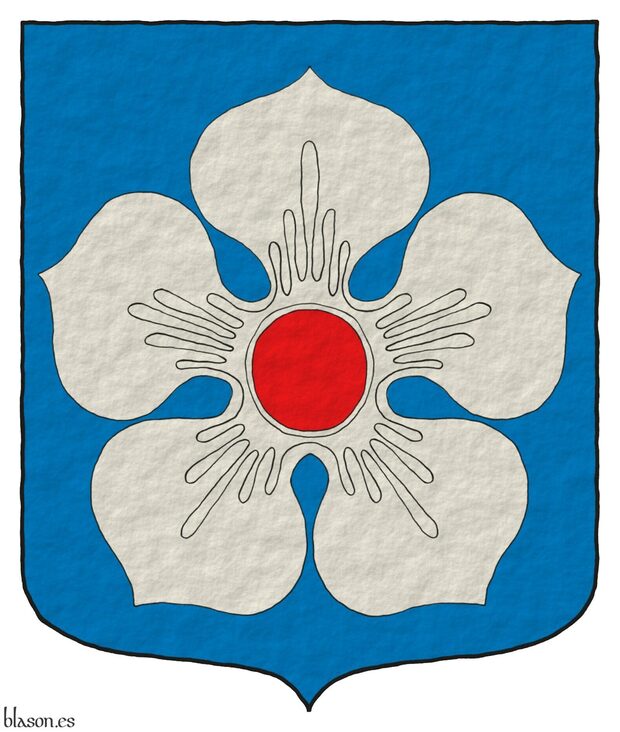
Azure, a cinquefoil Argent, seeded Gules.
Escudo de azur, un quinquefolio de plata, botonado de gules.
Coat of arms emblazoned by me with plain color Azure and metal Or and with a shape ended with an ogee arch.
Blazon keywords: Without divisions, Azure, One, Cinquefoil, Argent, Seeded and Gules.
Style keywords: Outlined in sable, Illuminated and Ogee.
Classification: Interpreted, Lineage, Kingdom of France, Civic and Coat of arms.
Bearer: Haguenau.


![Ver [Ferrer i Vives, F.; 1995] en referencias bibliográficas. Libro abierto, hojas de plata, filo de oro, guardas de gules, tapas de sable.](../css/Libro.Bibliografia.png)
Ferrer i Vives, F.; 1995
Francesc d'A Ferrer i Vives, «Heraldica Catalana», 3 volumes, Volume I A-F, Volume II G-P, Volume III Q-Z, ISBN of the complete work 84-7304-204-2, Legal Deposit B.20.464 - april 1995, Editorial Milla, Carrer de Sant Pau 21, Barcelona, 1995.
Bibliographical reference of century XX.
Classification: Catalan language and In black and white.
Author: Ferrer i Vives, Francesc d'A.
The following article cites this bibliographic reference:
Internal resources: Paper book.


![Ver [Garaycoa Raffo, L.; 2011] en referencias bibliográficas. Libro abierto, hojas de plata, filo de oro, guardas de gules, tapas de sable.](../css/Libro.Bibliografia.png)
Garaycoa Raffo, L.; 2011
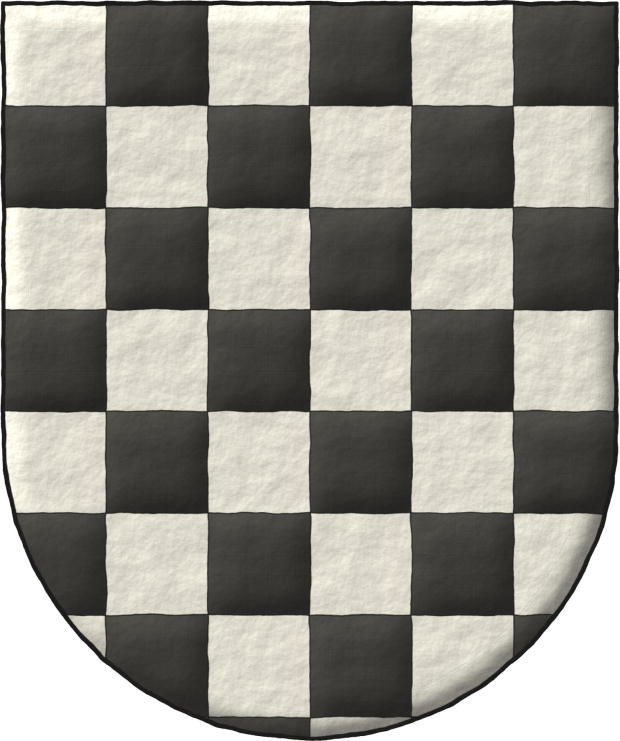
Lorenzo Garaycoa Raffo, Doctor, «Contribución Heraldica para el Estudio de la Sociedad Colonial de Guayaquil», pending to publish, graphic designer Lorenzo Garaycoa Taylor, with 320 surnames and 500 coat of arms, mainly of colonial coats of arms, main index on page 98, alphabetical index on page 99, 117 pages, Guayaquil, 11th of February of 2011.
Bibliographical reference of century XXI.
Classification: Castilian language and Black and white and color illustrations.
The author is Garaycoa Raffo, Lorenzo.
Internal resources: GaraycoaRaffoL2011.pdf.


![Ver [García Carraffa, A.; García Carraffa, A.; 1968] en referencias bibliográficas. Libro abierto, hojas de plata, filo de oro, guardas de gules, tapas de sable.](../css/Libro.Bibliografia.png)
García Carraffa, A.; García Carraffa, A.; 1968
Alberto García Carraffa y Arturo García Carraffa, with the colaboration of Armando de Fluviá y Escorsa, «El Solar Catalán, Valenciano y Balear», 4 volumes, Volume I Abad-Cebrián, 443 pages, Volume II Celma-Malda, 449 pages, Volume III Malendric-Quirant, 425 pages, Volume IV Rabasa-Zenarbe y apéndice, 516 pages, 1st edition, Heraldic Collection, edited by Librería Internacional, San Sebastián, 1968.
Bibliographical reference of century XX.
Classification: Castilian language and Black and white with color plates.
Authors: García Carraffa, Alberto and García Carraffa, Arturo.
The following articles cite this bibliographic reference:
Internal resources: Paper book.


Larre, lineage of Bayonne, French Basque Country
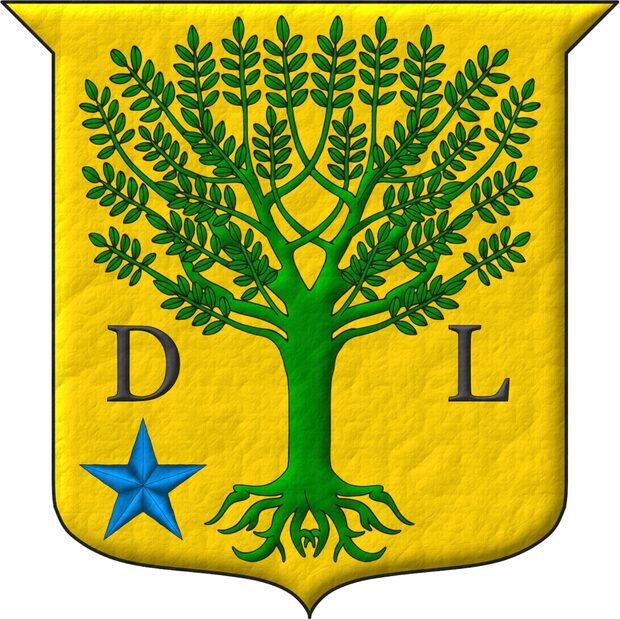
D'or à un arbre arraché de sinople, accosté à dextre de la lettre capitale «D» et à senestre de la lettre capitale «L» du même, et une étoile d'azur posée au canton dextre de la pointe.
Or, a tree eradicated Vert between a capital letter «D» and a capital letter «L» Sable, in the dexter of the base a mullet Azure.
Illuminated with lights and shadows and with a leather finish.
Blazon keywords: Without divisions, Or, One, Tree, Eradicated, Vert, Between, Letter, Sable, Canton, Dexter, Base, Mullet, Five and Azure.
Style keywords: Leather, Outlined in sable, Illuminated and Semi-circular.
Classification: Interpreted, Lineage and Kingdom of France.


![Ver [Mogrobejo Zabala, E. de; 1991] en referencias bibliográficas. Libro abierto, hojas de plata, filo de oro, guardas de gules, tapas de sable.](../css/Libro.Bibliografia.png)
Mogrobejo Zabala, E. de; 1991
Endika de Mogrobejo Zabala, «Blasones y Linajes de Euskalerria», 10 volumes, Volume I A-Alcerreca, Volume II Alciba-Angui, Volume III Angulo-Astu, Volume IV Astun-Bun, Volume V Busta-Elua, Volume VI Elus-Gorniz, Volume VII Gordu-Laca, Volume VIII Lacar-Merca, Volume IX Mere-Salez, Volume X Salinas-Z, edited by Editorial Amigos del Libro Vasco, printed by Grafo SA, ISBN of the complete work 84-7886-026-6, Legal Deposit BI-469-1991, Bilbao, 1991.
Bibliographical reference of century XX.
Classification: Black and white with color plates and Castilian language.
Author: Mogrobejo Zabala, Endika de.


Poumola, lineage of Catalonia
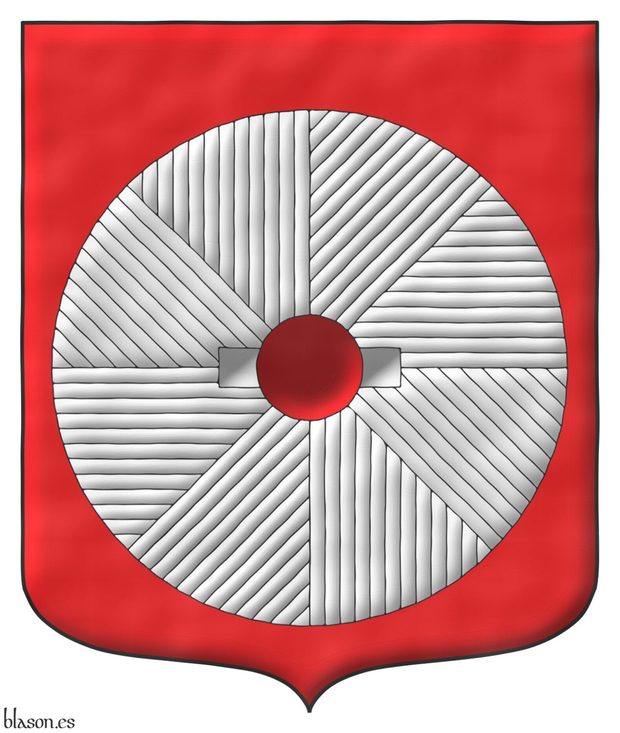
Blazon of the Poumola lineage of Catalonia.
Gules, a millstone Argent.
Escudo de gules, una piedra de molino de plata.
Illuminated and a watercolor finishing with shadow in the hole.
It blazon is describe in [Cadenas y Vicent, V. de; 1987; page 1429], [García Carraffa, A.; García Carraffa, A.; 1968; volume 3, page 358], and [Ferrer i Vives, F.; 1995; volume 2, page 362].
In this case, my theory is that this coat of arms is an example of «canting arms». «Canting arms» use a word or words of the surname or inside the surname to make the coat of arms. The surname Poumola is from Catalonia, we can split the surname into 2 parts «pou-mola», in Catalonian language a) «pou» means «well» and b) «mola» means «millstone» ~ «cadascuna de les dues pedres de forma circular que componen el molí», [GDLC; 1998], and this could be the reason of the symbolism of this coat of arms. «Canting» in heraldry means «talking» or «chatting», in Spanish «canting arms» is translated as «armas parlantes». Some heralds call «canting» to this creative technic.
Blazon keywords: Without divisions, Gules, One, Millstone and Argent.
Style keywords: Watercolor, Outlined in sable, Illuminated and Ogee.
Classification: Interpreted, Lineage and Canting.


![Ver [Rietstap, J. B.; 1861] en referencias bibliográficas. Libro abierto, hojas de plata, filo de oro, guardas de gules, tapas de sable.](../css/Libro.Bibliografia.png)
Rietstap, J. B.; 1861
Johannes Baptista Rietstap, «Armorial général, précedé d'un Dictionnaire des termes du blason», edited by Gerrit Benjamin van Goor, 2 volumes, Volume I from A to K, 1149 páginas, Volume II from L to Z, 1316 páginas, Gouda, 1861.
Bibliographical reference of century XIX.
Classification: French language.
The author is Rietstap, Johannes Baptista.
Bibliographic reference mentioned in the following articles:
External resources:
- Deuxième édition refondue et augmentée, 1884-1887, volume I, A-K.
- Deuxième édition refondue et augmentée, 1884-1887, volume II, L-Z.
- Gerrit Benjamin van Goor.
Internal resources: RietstapB1861.10.ArmorialGeneral.A.Z.txt in ASCII format in French with 126,068 blazons, RietstapB1861.10.ArmorialGeneral.A.Z.doc in Word format in French, RietstapB1861.11.ArmorialGeneral.A.K.pdf in PDF format in French and RietstapB1861.12.ArmorialGeneral.L.Z.pdf in PDF format in French.


Talbot, lineage of England
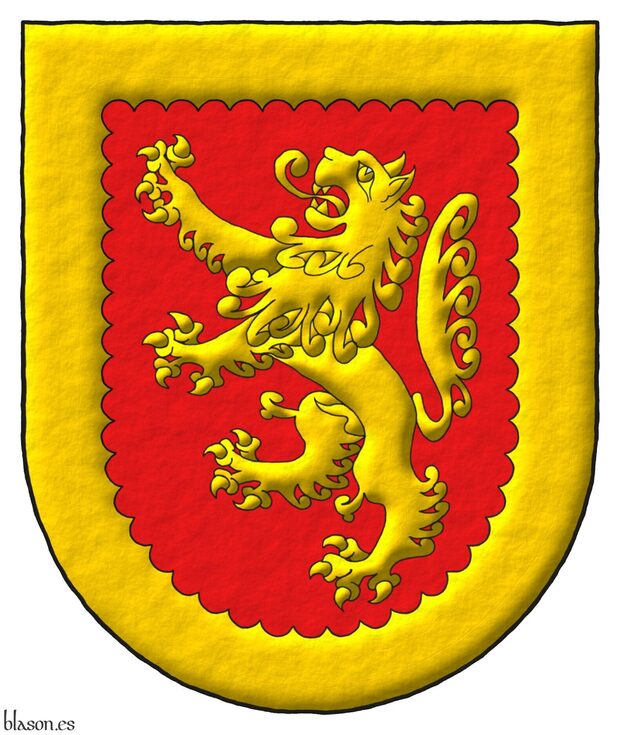
Blazon of the Talbot lineage of England.
Escudo de gules, un león rampante dentro de una bordura angrelada todo oro.
Gules, a lion rampant within a bordure engrailed Or.
Illuminated with lights and shadows and with a freehand finish.
[Rietstap, J. B.; 1861] writes it in French as «de gueules, au lion d'or, à la bordure engrelée du même».
Blazon keywords: Without divisions, Gules, One, Lion, Rampant, Within, Bordure, Engrailed and Or.
Style keywords: Freehand, Outlined in sable, Illuminated and Semi-circular.
Classification: Interpreted, Lineage and Kingdom of England.


The coat of arms of Rodelo lineage from Galicia in 3 steps
Gules, six wagon-wheels Or, 2, 2, and 2.
Blazon keywords: Gules, Six, Wagon-wheel and Or.
Style keywords: Outlined in sable, Plain tincture, Illuminated, Freehand and Pointed.
Classification: Lineage, Interpreted, Canting, Coat of arms and Schema.
Bearer: Rodelo lineage from Galicia.


Vilardi, lineage of Italy
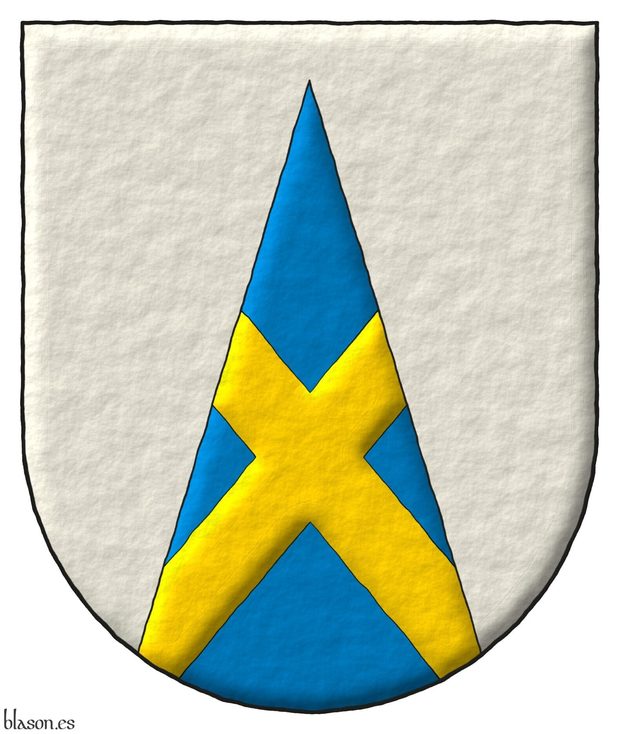
Blazon of the Vilardi lineage of Italy.
Argent, on a pile issuant from the base Azure a saltire Or.
Escudo de plata, una pira de azur cargada de un sotuer de oro.
Illuminated and a free hand finishing.
[Cadenas y Vicent, V. de; 2002; page 138] says that the a pile issuant from the base is «a triangle whose base issues from the base of the shield, being a third of its width», but when it is painted in [Cadenas y Vicent, V. de; 2002; page 268, figure 279] along with the pile the width of the base of both isosceles triangles is 2/3 of the width of the shield. I think the width of 2/3 is, in these 2 cases, better than 1/3 width, because with 1/3 there is not enough room for charges, as shown in the figure below.
There are scholars who say that the pile issuant from the base must not touch the upper edge of the shield and others that its tip should be in the center of the chief. In the previous image, the pile issuant from the base of the 1st shield fulfills the first affirmation, and in the 2nd shield, its tip is in the center of the chief.
I have the doubt if it should not be a saltire raguly.
Blazon keywords: Without divisions, Argent, One, Pile issuant from base, Azure, Charged, Saltire and Or.
Style keywords: Freehand, Outlined in sable, Illuminated and Semi-circular.
Classification: Interpreted, Lineage and Italian Republic.
-
Language
-
Categories of heraldry
-
Divisions of the field
- Without divisions
- Party per pale
- Party per fess
- Party per bend sinister
- Tierce
- Tierce sinister
- Tierced per bend
- Quarterly
- Quarterly per saltire
- Gyronny
- Party per fess, the chief per pale
- Party per pale, the sinister per fess
- Party per fess, the base per pale
- Party per pale, the dexter per fess
- Party per chevron
- Indented
- Enté en point
- Flanched
-
Metals
-
Colours
-
Furs
-
Other tinctures
-
Ordinaries and sub-ordinaries
-
Diminutives of the ordinaries
-
Other charges
-
Charges from Nature
Eagle, Two hands clasped, Lark, Tree, Rainbow, Trunk of a tree, Atom, Barbel, Acorn, Arm, Owl, Horse, Head, Thistle, Stag, Doe, Crescent, Increscent, Tail, Heart, Roe deer, Neck, Roe deers' attires, Raven, Dolphin, Diamond, Tooth, Elephant, Starling, Mullet, Estoile, Male figure, Fleur de lis, Hop cone, Puffin, Ash, Paw, Goose, Seagull, Pomegranate, Sunflower, Falcon, Leaf, Flame, Boar, Barn owl, Lion, Lioness, Lion passant, Leopard, Lion rampant guardant, Lynx, Lily, Wolf, Hand, Apple, Martlet, Wing, Two wings in vol, Covert, Mount, Trimount, Wrist, Orbital, Bear, Palm tree, Poplar leaf, Paw, Peacock, Chest, Dog, Brach hound, Fish, Hoof, Quill, Cinquefoil, Quetzal, Branch, Oak, Rose, Double rose, Serpent, Sun in splendour, Ray of the sun, Stem, Wheat, Wheat spike, Bull, Tulip, Udder, Escallop and Fox.
-
Artificial charges
Halberd, Plough share, Ace of spades, Cyclamor, Torch, Harp, Non-classic artifact, Ship, Beret, Grenade, Ecclesiastical cap, Chain, Covered cup, Bell tower, Cannon dismounted, Carbuncle, Castle, Clarion, Nail, Cord, Dagger, Key ward, Turret, With a turret, Sword, Sabre, Scroll, Arrow, Garb, Gauntlet, Buckle, Spear, Spear's head, Letter, Book, Line, Key, Four crescents joined millsailwise, Hammer, Menorah, Number, Knot, Celtic Trinity knot, Parchment, Piano, Millstone, Millrind, Millwheel, Bridge, Hourglass, Chess rooks, Compass rose, Rosette of acanthus leaves, Mullet of six points pierced, Portcullis, Wheel, Wagon-wheel, Symbol, Sackbut, Drum, Tower, Trident, Double vajra and Anvil.
-
Immaterial charges
Angel, Heart enflamed, Sacred Heart of Jesus, Paschal lamb, Dragon, Phoenix, Griffin, Winged hand, Pegasus, Saint George, Trinity, Triton, Golden fleece and Unicorn.
-
External elements
-
Heraldic creations
-
References
-
Formats
-
Keywords on this page
Watercolor, Annulet, Pointed, Azure, Bibliography, Bordure, Five, Ogee, Outlined in sable, Dexter, In black and white, Black and white with color plates, Interlaced, Coat of arms, Mullet, Fleur de lis, Personal, Gules, Haguenau, Illuminated, Interpreted, Chief, Motto (motivation), Castilian language, Catalan language, French language, English language, Letter, Lion, Lineage, Manuscript, Semi-circular, Or, Canting, Party per pale, Millstone, Argent, Without divisions, Base, Kingdom of France, Kingdom of England, Sable, Century XIX, Century XX, Century XXI, Vert, Freehand, Three and One.
